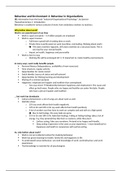Behaviour and Environment 2: Behaviour in Organisations
(B): Information from the book “Industrial-Organizational Psychology”, by Spector
Theoretical lecture 1: Introduction
Behaviour is studied in various contexts of work, from ambulance workers to teachers.
Why bother about work?
Work is an essential part of our lives
Work is super prevalent: > 3.5 billion people are employed
Work is super invasive:
o Full-timers spend half of waking time on work
o Private time is partly spent on work (overtime, commuting, thinking about work)
70% does overtime regularly, 30% does overtime on a structural basis. This is
very bad for your mental health.
o Impact on health, happiness and personality
Work is here to stay
o Working life will be prolonged (67+) Important to create healthy environments.
In many ways, work really benefits people
Personal finance (independence, availability of new resources)
Time structure, regular activity
Opportunities for social contact
Social identity (source of status and self-esteem)
Opportunities for lifelong learning and development
Sharing of a common purpose
Happiness: employed are happier and healthier than unemployed
o Two way street Relationship between happiness and employment. The cause and
effect go both ways. People who are happy and healthy can easier find jobs. People
who have a job are happier and healthier.
… but work has drawbacks
Culture phenomenon: a lot of songs are about work as well.
Statistics show:
o 25% say work affects their health negatively
o 12% in EU and 24% in NL say work affects their health positively
o A lot of workers say they have to work on complex task and with at a high speed
Due to technology, the easy tasks are gone.
o 31% in EU and 18% in NL hide their feelings. Faking or hiding feelings takes a lot of
energy. E.g. they pretend they like their co-workers, while they don’t.
Surface acting: Fake your emotions. Pretend to be happy and friendly.
Deep acting: Expression is the same as your experience. = more beneficial for
happiness and health in comparison with surface acting.
So, why bother about work?
Work is not an incidental context for studying behaviour
Work has great meaning for health, family life and happiness in life
To understand human behaviour, we need knowledge of work, work behaviour and work
experiences
That knowledge is essential for all psychologists
,The scope is dynamic
The scope has a strong interaction with societal changes.
On a organisational level, organisations need more
flexibilization (operational, structural, strategic) because the
environment is rapidly changing. Leads to life long learning
and development.
Intensification: the easy tasks disappear. Digitalisation:
keeping up with technological changes.
Mentalisation: shift from working in the industry to working
with the head.
Prolonged working life: Economic reasons. Too many people get older.
Life expectancy is rising Steady rise all over the world.
What about healthy life expectancy ?
= the number of years in a healthy state, grow old in a healthy way
It is not rising to a similar extent, if at all It’s rather stable.
It is strongly related to educational level (no gender differences) People with a lower
education have a less long healthy life expectancy. This is due to the quality of work (poorer
jobs), lifestyle (they live less healthy) and a longer exposure to work (start younger).
Welfare diseases (diabetes) are increasing
People with a higher education have a healthy life expectancy of 72, while people with a
lower education have an expectancy of 50. So should everyone have a longer working time?
What does W&O psychology involve?
How can W&O psychology contribute towards helping people work in a motivated, productive and
healthy way during their entire working life?
Three overlapping subdisciplines
Work (and Health) psychology
How should work, work conditions and work and resting times be structured in order to guarantee
work quality and good health, and to optimise performance?
Job design, fatigue, stress, motivation, sickness absence
Organisational psychology
How should organisations and business processes be structured to make people collaborate as
efficiently and effectively as possible?
Organisational structure & culture, leadership, organisational change, dealing with resistance
,Personnel (HR) psychology
How can we ensure an optimal P-E fit in which individual capacities and desires (continue to) match
work demands and opportunities within the organization?
Recruitment & selection, development of competences, performance appraisal, (financial) reward
systems
History of W&O psychology
W&O psychology is nearly as old as psychology itself
1892: opening of first psychological laboratory in the Netherlands, Heijmans
Wundt: The founding father of empirical psychology. He started with experiments.
Münsterberg: Applied all the psychological knowledge. Talked about topics like fatigue in
organisations.
Taylor: He started studying the behaviour of employees in time and motion studies. He
mapped the work activities. He developed different shovel for different types of materials,
which increased the productivity. He also used a stopwatch: he measured the time of all the
activities. He improved the productivity of this shovel business with 400%. But, a lot off
people got fired, because the acquired skills got higher and less people were necessary. He
didn’t have an eye for the human side.
Frank & Lillian Gibreth: More eye for wellbeing of humans.
Scientific Management (1911) = Taylor
Assumptions:
‘One best way’: efficiency (time & motion studies)
Employee is lazy by nature
Piecework pay: money is the only motivator payment for pieces of work
Managerial control over job performance is essential: more profit Managers need to
control the employees
Four principles Scientific Management (1911)
1. Scientific approach: time & motion studies
2. Selection of right worker for the job most efficient employees
3. Training and development of worker
4. Strict separation of head and handwork: managers think, workers do
, Practice:
Worker is extension of machine not taking seriously
Workers were exploited
Protest from labour unions the human conditions were bad
US Congress investigation stopwatch forbidden in public sector, not in private sector
Modern forms of Scientific Management
McDonalds Very standardised. No cognitive skills required.
Call centres Written texts they have to speak out, no improvisation.
Ryanair
= Taylorism is alive and well!
Till World War I and after
1913: The first assembly line Ford Motor Company
Man is extension of machine
Standard products T-Ford
Mass production
No right to labour unions
Ford ‘gestapo’ and culture of fear Safety cards who created a culture of fear.
He implemented the ideas of Taylor
The Ford became cheaper, so it was affordable for more people.
Henry Ford (1863-1947)
High nazi-award from German Government (30-7-1938) He was against Judes and immigrants and
had hardly any respect for workers.
Unionism not Fordism The employees started strikes, because they wanted to be treated
better.
Ford Head Quarters, Battle of the overpass (1937) It changed the credit that Henry Ford
had built up.
Ford’s security force attacks leading union organizers The photographers placed the
photos in the newspapers.
Between the World Wars
Yerkes developed intelligence tests. Were controversial, because they were cultural biased.
The north European immigrants performed way better than the south immigrants
Selection Psychology.
More selection collaboration from 1920s
Human Relation movement: more social aspect
World War II: Selection and ergonomics were dominant






